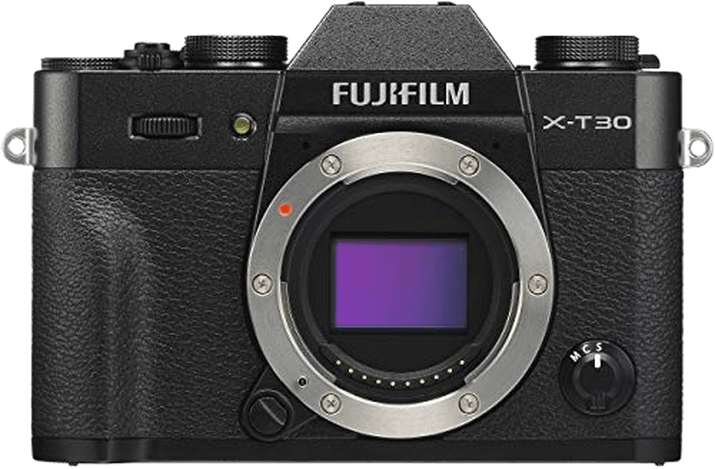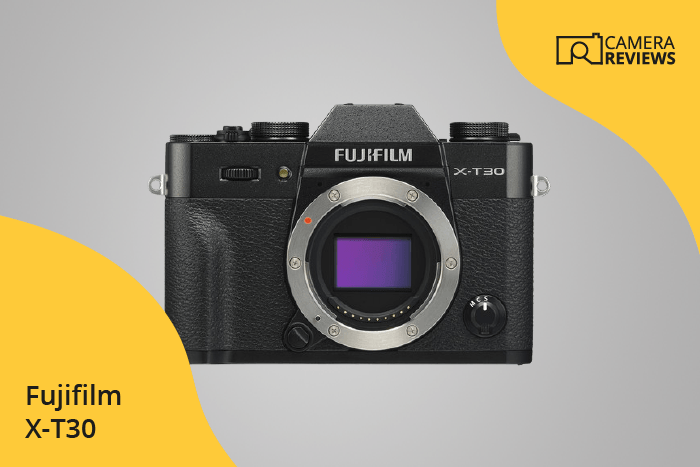Fujifilm X-T30 Specs and Scores

The Fujifilm X-T30 receives a score of 65/100, making it a solid contender in the mirrorless camera market. Announced on February 14, 2019, and released the same year, this camera is priced at $899. Its dimensions are 118 x 83 x 47mm, and it weighs 383g or 0.84lbs.
These specifications show that the X-T30 is a compact and lightweight camera, suitable for photographers seeking convenience without compromising on quality. Its competitive price and decent score make it a worthy option for those considering a mirrorless camera.
Fujifilm X-T30 Overview and Optics
The optics of the Fujifilm X-T30 receive a score of 67 out of 100. This camera boasts a 26-megapixel APS-C CMOS sensor, which is competitive in today’s market. The X-T30’s shooting speed is 30 frames per second, providing excellent performance for capturing fast-moving subjects. Its X-Processor 4 ensures speedy processing, contributing to the camera’s overall efficiency.
The Fujifilm X-T30 has a Fujifilm X lens mount, which allows for a wide range of compatible lenses. However, it lacks image stabilization, which could affect image quality in certain shooting conditions. The camera has a 3:2 aspect ratio, which is standard for most DSLRs and mirrorless cameras.
Considering these specifications, the Fujifilm X-T30 offers respectable optics in the current market. While it may not be the top performer in every category, its combination of features provides a solid foundation for capturing high-quality images.
Fujifilm X-T30 Video Performance
The Fujifilm X-T30 boasts a remarkable video score of 91 out of 100, showcasing its impressive capabilities in this domain. It offers a maximum video resolution of 4K with dimensions reaching 4096 x 2160 pixels, ensuring crisp and detailed footage. The camera also supports a high frame rate of up to 120fps, providing users with the ability to capture smooth slow-motion sequences.
In today’s market, the Fujifilm X-T30 stands strong with its competitive video specifications. The built-in time-lapse functionality further enhances its appeal to videographers, allowing them to create captivating visuals with ease.
The Fujifilm X-T30 excels in the video department, making it a strong contender for those seeking advanced video capabilities in a compact camera. Its high score of 91 reflects its superior performance and features that cater to modern videography needs.
Fujifilm X-T30 Features and Benefits
The Fujifilm X-T30 receives a feature score of 70/100. With a 3-inch screen size and a resolution of 1,040,000 dots, this camera offers a clear and reasonably large display. The touchscreen and flip screen capabilities make it user-friendly and versatile for various shooting angles.
In today’s market, the lack of GPS may be a slight drawback for some users. However, the camera compensates with both WIFI and Bluetooth connectivity, allowing for easy image sharing and remote control functionality.
The specifications of the Fujifilm X-T30 reveal it as a solid choice for photographers seeking a balance between advanced features and user-friendly design. Its feature score and specifications prove it to be a competitive option within the current camera market.
Fujifilm X-T30 Storage and Battery
The Fujifilm X-T30 receives a storage and battery score of 35/100. It offers a single memory card slot, which accepts SD, SDHC, and SDXC cards with UHS-I compatibility. In today’s market, many cameras provide dual card slots for added convenience and storage capacity, making the X-T30’s single slot less competitive.
Regarding battery life, the X-T30 can capture 380 shots using the NP-W126S battery type. This battery life is not impressive compared to other cameras in its class. However, the camera does support USB charging, which can be a useful feature for on-the-go photographers.
Taking these factors into account, the Fujifilm X-T30’s storage and battery capabilities are adequate but not outstanding.
Fujifilm X-T30 Alternatives
Do you want to know how the Fujifilm X-T30 compares to its competitors? Have a look at the most popular comparisons for this camera below:
- Fujifilm X-T30 vs X-T30 II
- Fujifilm X-T3 vs X-T30
- Fujifilm X-T30 vs X-T4
- Fujifilm X-S10 vs X-T30
- Fujifilm X-T30 vs Sony a6400
- Fujifilm X-T200 vs X-T30
Fujifilm X-T30 FAQ
Does the Fujifilm X-T30 Have Built-in Image Stabilization?
The Fujifilm X-T30 does not have built-in image stabilization. To achieve stabilized shots, you can use lenses with optical image stabilization (OIS) features.
Does the Fujifilm X-T30 Support 4K Video Recording?
Yes, the Fujifilm X-T30 supports 4K video recording at 30 frames per second, providing high-quality video footage for various applications.
What Size Sensor Does The Fujifilm X-T30 Have?
The Fujifilm X-T30 features an APS-C size sensor, which is a popular choice for many DSLR and mirrorless cameras, offering high image quality and performance.
Does the Fujifilm X-T30 Have a Dual Memory Card Slot?
No, the Fujifilm X-T30 has only a single memory card slot, which supports SD, SDHC, and SDXC cards for storing your photos and videos.
Does the Fujifilm X-T30 Have a Touch Screen?
Yes, the Fujifilm X-T30 features a touch screen, allowing users to easily navigate menus, select focus points, and review images with intuitive gestures.
Does the Fujifilm X-T30 Have Wi-Fi and Bluetooth?
Yes, the Fujifilm X-T30 is equipped with both Wi-Fi and Bluetooth capabilities, enabling wireless image transfer and remote camera control through compatible devices.
Does the Fujifilm X-T30 Have GPS?
No, the Fujifilm X-T30 does not have built-in GPS functionality. However, you can use a compatible smartphone to geotag your images via Wi-Fi and Bluetooth connections.
Is the Fujifilm X-T30 Weather Sealed?
No, the Fujifilm X-T30 is not weather sealed. Users should exercise caution when using the camera in challenging weather conditions or invest in weather-resistant accessories.
Does the Fujifilm X-T30 Have a Built-in Flash?
Yes, the Fujifilm X-T30 comes with a built-in pop-up flash, providing additional lighting when needed in low-light situations.

